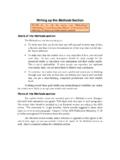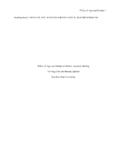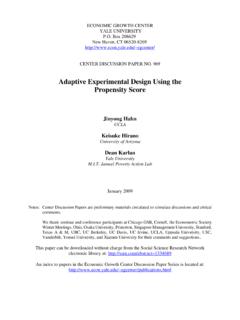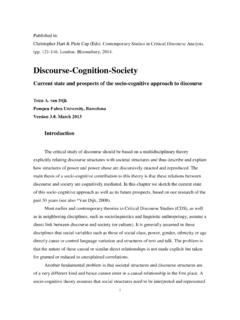Transcription of Sample Closing paragraphs - Mike Dillinger
1 Sample Closing paragraphs Below are two example Closing paragraphs where you can see very clearly the outstanding issue, a quick summary of the specific background section, some mention of importance, and a quick sketch of the present study. Sample #1. There has not been much research in the specific area of reading comprehension <Outstanding issue and time limitations. Individuals may need more time to complete tests, but time limitations may greatly lower their scores. Background noise and time constraints affect <Summary reading comprehension by distracting the individual from actively decoding a reading passage's message.
2 The present study will involve testing participants on their ability to read an assigned passage and answer questions while television and time constraints are <The present study present. Contrasting this research to participants tested with no noise and no time constraints affects reading comprehension due to environmental differences. This research will provide individuals as well as educational institutions the ability to understand the <Importance environmental conditions necessary for reading comprehension. This study observes time limitations and television exposure on reading comprehension among native English speaking adults.
3 Sample #2. Past research has suggested that prior knowledge and text signaling affect recall. <Summary However, much of the interactional studies between the two factors focus on recall of summaries or texts within a school textbook. Additionally, there exists some discrepancy <Outstanding issue surrounding prior knowledge and whether it significantly facilitates learning. The present <The present study study will assess participants on their ability to accurately recall facts from a brief article based on their prior knowledge and presence of text signals.
4 This research will provide <Importance government officials, educators, and others with a better understanding of how to write more effectively in order to cater to different populations based on background knowledge and interests. In the Sample Closing paragraphs below, how good a job did the authors do? Is it clear exactly what they will be studying and why it is important? Discuss with your partner what you think works and do not work in the different ways that the authors below presented their research problems. Sample #3. Furthermore, there is a research group that investigates the usability of Web pages (Morkes and Nielsen, 1997).
5 It is categorized into a field of computer engineering and is named as a research field of human computer interactions. The two research streams that investigate cognitive processes of readers scarcely have connections with research achievements of the human computer interactions. Even the two research streams to investigate the cognitive processes of readers seem to have little exchange with each other. For example, reading models advocated for print text have not been integrated into those related to reading hypertext. In other words, the three research streams that are related to the topic of this paper seem to have remained independent of one another.
6 Given this background, this paper tries to investigate the kinds of strategies ESL learners use when they read through the authentic pages on the Internet, incorporating all the knowledge about reading processes for print text both in L1 and L2, about hypertext and about Web navigation. Konishi, M. (2003). Strategies for reading hypertext by Japanese ESL learners. The Reading Matrix, 3, 3-18. Sample #4. The top-down approach to designing interfaces for assembly, then, provides two cognitive design principles: First, structure the interface to match the structure of the procedure to be taught.
7 This means the interface should explicitly represent the hierarchical structure of the task to be performed. Second, use text and pictures, with a question mark on animated versus static pictures. We applied these principles to the design of interfaces for two different assembly tasks, assembly of a saxophone and assembly of a toy bug from a construction kit. For the saxophone, we had determined the hierarchical structure from previous research (Zacks et al., 2001), but we double checked and refined the hierarchy for this experiment. For the toy assembly, we built in the hierarchical structure into instructions.
8 The tasks differ in several ways. Although order of assembly is constrained in both, that is, certain operations must be accomplished before others; there are fewer constraints in the toy assembly. Zacks, J. & Tversky, B. (2003). Structuring Information Interfaces for Procedural Learning. Journal of Experimental Psychology: Applied, 9, 88 . 100.






